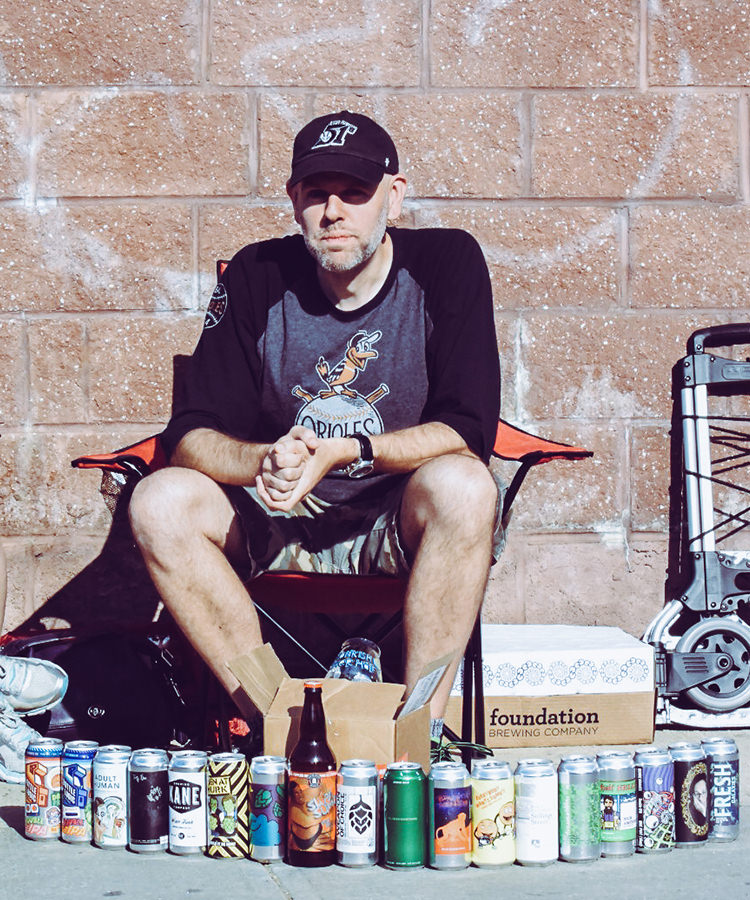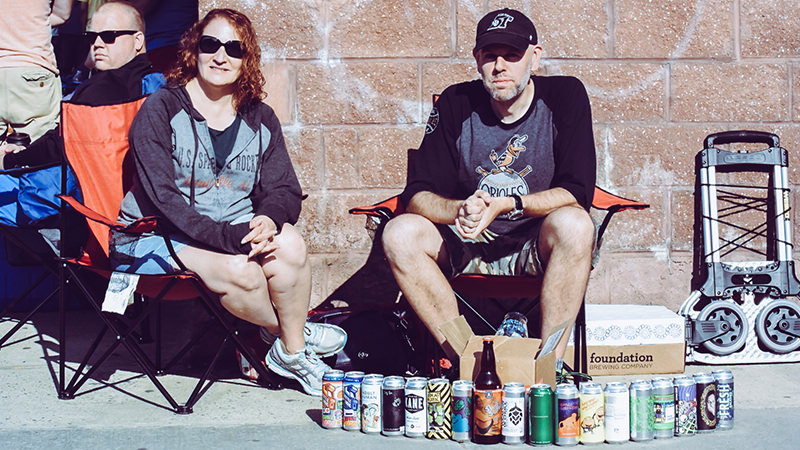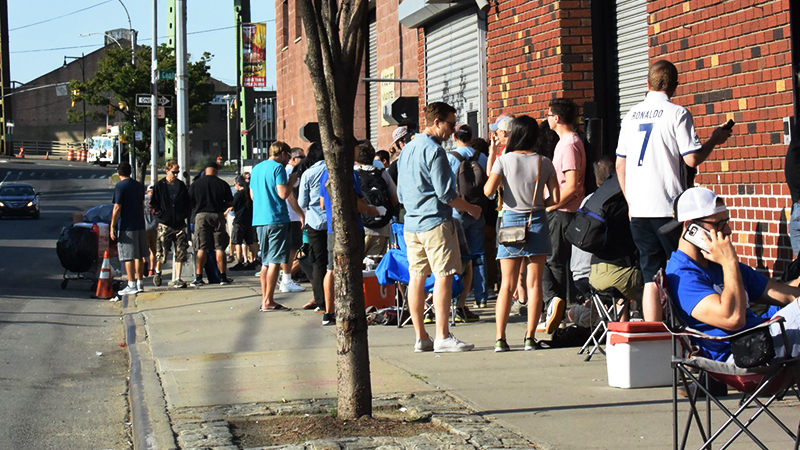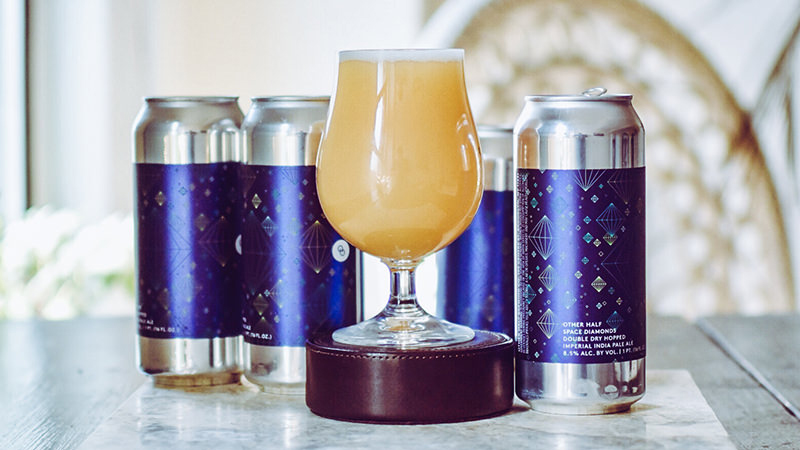It’s 8 a.m. on a slightly chilly, 64-degree morning in late August in New York. I’m in a Lyft heading to 195 Centre Street in Brooklyn, and my driver does a double take on the address before asking me to check if it’s correct.
“Huh,” he sighs as he retypes the address into his phone. “I didn’t know there was a 195 Centre Street in Brooklyn.”
The address is for Other Half Brewing Company. And while my mom would argue that it’s deplorable to go to a brewery at 8 a.m., I’m not the only one here.
Other Half is one of many breweries around the country that release small batches of fresh and hazy New England IPAs to hundreds of their most devoted fans. Breweries up and down the coasts announce special release beers on certain dates and times, then sell out before anyone but the most dedicated drinkers can try them. Some of the most notable crowd-drawing breweries are Trillium (with whom Other Half collaborates), Toppling Goliath, and Monkish.
When I get close to the destination I hear my driver laugh a little and say “this must be it.” I look up from my phone and see a line of people wrapping around the block against the building wall. Some are in lawn chairs, some have coolers, and many have a wall of full beer cans in front of them. I feel like a kid being dropped off at the end of the line for his first roller coaster ride. I’ve made it.
I’m here because I like the beers that Other Half makes, but also because I heard a tip that you don’t have to wake up early to score special release beers. You can sleep in, go a couple hours late, skip the line, and still get what you want.
Is this true? That would be ideal, because I don’t do mornings. But if it is true, why would anyone with any semblance of a social life go to a remote corner of Brooklyn before the sun came up on a Saturday?
The answer, like all things in beer, is more complicated than you’d think.
Trading Post
For ephemeral-obsessed, Instagram-savvy beer drinkers, special releases are peak zeitgeist. Breweries announce limited edition beers on their Instagram feeds, drawing comments, tags, and likes. You can almost feel followers and friends of followers marking the date on so many Google calendars minutes after the release is announced.
I know because I’m one of them. Like countless other 20-somethings in this country, I’m addicted to Instagram. Scrolling through beer photos is how I learned about this Other Half release in the first place.
On Tuesday, August 22, Other Half posted two pictures of four beers on Instagram. “Info for our Saturday 8/26 can drop. Starting at 10am we will have DDH Space Diamonds, DDH Daydream in Green, Baby Diamonds and Cream Get the Honey.” Underneath was information on the purchase limit (one case), size (four-packs of 16-ounce cans), and price ($16 to $20 per four pack) of each beer. Comments immediately flooded in of people saying they were going and which beers they were most excited for.
https://www.instagram.com/p/BYG5B9LH4DH/?taken-by=otherhalfnyc
Instagram is the preferred method of communication for both the breweries and their fans. The breweries announce on Instagram, and the fans flock to the comments section, where they arrange trades for rare beers from other breweries.
The letters “FT” in a comment mean “for trade,” and the letters “ISO” in a comment mean “in search of.” Scrolling through the FT and ISO beers in the comments to this Other Half post was like parsing a who’s who of trendy breweries. Drop a couple of the beer names on that list and you might just convince someone you know a thing or two about good (read: cult worthy) beer.
“I’m not a huge social media guy, but I do Instagram for this,” Adam Seidel informs me. He’s a middle-aged man who drove in from Long Island at 5 a.m., and got to the brewery around 7 a.m. When I arrived at 8 a.m., he was standing about 50 feet from the front of the line. “I don’t follow people on Instagram, people don’t follow me.”
Seidel is wearing shorts and an Orioles baseball shirt with a well-worn hat pulled just low enough to block the sun. I make a mental note about the importance of dressing appropriately for a beer release. This is a useful tip for morning releases. I can already feel the slowly rising sun burning my neck and arms.
I turn to ask the woman waiting with Seidel, Vicky Granados, a question. A guy Seidel met on Instagram (though presumably someone who doesn’t follow him) immediately walks up with a can in hand.
“Hey man, I traded with you last week and saw some other stuff you have,” the guy says, pointing to the line of beers in front of Seidel. He asks if he can trade the beer he has for the C39 from Tree House Brewing Co. that Seidel brought.
Nope. A single can of C39 goes for $29.50 on My Beer Collectibles. They barter like it’s the most normal thing in the world to be haggling over double-hopped hazy IPAs on a dingy Brooklyn sidewalk before 9 a.m. Seidel pushes forward another, less rare, beer for the trade and the guy takes it.
“Usually I don’t take it if I’ve had it before,” Seidel tells me after the guy leaves. He reaches behind him and pulls a blanket off of a case of beers. He snaps the beer he just received onto a holder and puts another of the one he traded out in front of him. I’ve never seen so many rare, cold craft beers lined up unopened, with not a single person drinking.
These trades are one of the big reasons people come early and wait in line. During the couple of hours I hang around, people walk up and down the line and examine each other’s offerings. I intermittently check Instagram like everyone else around me is doing, and the comments on Other Half’s original release post continue to grow. Most of the trades start over the phone via Instagram, and then one person in the trade walks over to hand deliver the beer in person. Amongst the trade dialogues are frequent line updates for people who haven’t got there yet. There are 131 comments on Other Half’s original announcement post by the end of the day.
Trading beers isn’t new in the craft beer world. There’s an entire sub Reddit with 18,809 members devoted solely to beer trading. BeerAdvocate has a section of their website dedicated to beer trades. There’s even an app called The Beer Exchange.
It’s hard to beat the in person atmosphere, though.
“I do trades just with my friends,” says Mark Shin, who rode the F train from Queens with two empty duffel bags. “I used to do them online but they’re so picky,” he says of other traders, many of whom have very particular wish lists. “I don’t give a shit how long you waited for a beer man, we all waited! $200 for a Goose Island Bourbon County? We’re not in the beer selling business you fuck.”
I laugh, then take a second look at his duffel bags. He didn’t carry any beers with him to trade in line, but the duffel bags will come in handy when he’s ferrying his haul back to Queens. Tip two: bring appropriate carrying gear.
Not everyone is so specific about who they’ll trade with. Standing in line at around 10:30 a.m., I see someone drive their car up to the line, pass two beers out of the window and get two in return, and then back his Honda CR V out onto the street and drive away.
Shortly after, I overhear someone on the phone ask, “What’s Trillium cooking up man? What’s so good that you’ve got me in the two-hour wait here for a trade?”
Staying Fresh
No matter which brewery people line up for, the beers being released usually have one thing in common: they’re hazy, thick, New England IPAs.
“People are fanatical about it, to the point they don’t want to drink anything else,” Sam Richardson, the brewmaster and founder of Other Half, told the New York Times in February. “Everyone has this expectation of getting hazy IPAs in a can directly from the brewery.”
Nearly all beer is better when fresh, but you don’t see people lining up across the country for stout releases or saisons.
To be fair, there’s more IPA (and, increasingly, New England IPA) made than any other type of craft beer, so there’s more opportunity for people to line up for one. But heavy-hopped beers are a ticking time bomb.
The flavor of hops in beer will start to noticeably decrease after about three weeks from the date of production. The beer doesn’t expire in a traditional sense, but it loses a lot of its hop notes. Big hop notes are what define IPAs and NEIPAs, so the fresher the better — and there’s nothing fresher than straight from the brewery on the first day of sales.
Heady Topper from The Alchemist was one of the first cult status IPAs. The beer is only available a short distance away from the Vermont brewery, and it’ll often sell out within hours of being released. Newer breweries are following in The Alchemist’s footsteps with small distribution of beers with big, rapidly degrading flavors.
Craft beer lovers who search for the biggest, freshest flavors out there are willing to wait, and breweries are willing to provide — despite the fact that many brewers I’ve spoken with claim that special releases are the most overhyped, not-worth-it craft beers on the market.
For the breweries succeeding in the special release game, though, it’s a godsend. These beers are expensive, even for craft. Selling straight from the brewery means they get to skip the middleman distributor and take in a higher percentage of the profits. Not to mention the brand-building hype and virtual guarantee that special release NEIPAs almost always sell out.
“This is the best thing that’s happened to breweries in the 30-plus years of the craft-beer revolution,” Richardson told the Times.
Selling Out
https://www.instagram.com/p/BMIgAYOhNrX/?taken-by=otherhalfnyc
Other Half officially opened for business at 10 a.m. on Saturday. I arrived around 8:30 to a line that had already turned the first and second corners around the block from the brewery. Seidel, who was right around the first corner and near the front, arrived at 7 a.m. Shin was around the second corner and arrived around 9 a.m. Once Other Half opened their doors, it took around an hour and fifteen minutes from the spot that Shin was at to reach the front of the line.
The longest Shin has ever waited for a beer was when Other Half collaborated on a beer with Trillium called Like Whoa. The line for the beer started as soon as Other Half closed the night before. Shin got there at 3 a.m. and was hours away from the front of the line. For most releases, though, if he comes at 12 p.m. he can make it to the front of the line at 1 p.m. If he wants to make sure he gets everything being released, he says, he comes at 9 a.m.
At 10 a.m. when the sales start, I go to the back of the line and wait. About 10 minutes in, a guy from Other Half walks to the back and announces that the All Green Everything they released on Wednesday is sold out, but everyone in line will get some of today’s releases. This is good news.
It doesn’t always work out like this. A couple weeks ago, Seidel tells me, he nearly missed out on a beer after waiting for hours.
“I came at 11 a.m. and got three out of the four releases,” he says. “A brewer walked out and counted the line and said, ‘Up to here won’t get this beer.’ Then he came again and said, ‘Up to here won’t get this beer either.’ I caught the last four pack of the day for that last beer.
“The beer gods don’t normally smile on me, but they did on that day.”
I get to the front of the line and get my beer about an hour and fifteen minutes after starting in the back of the line at 10 a.m. The line is nearly nonexistent by the time I leave, and as I wait for my Lyft, I see someone park in front, walk straight into the brewery, purchase their beer and leave.
On Sunday at 12 p.m., Other Half updates a post about the beer release: “Sold out of Day Dream, Space Diamonds and Honey. No line and plenty of beer. We have Helles and Baby Diamonds available.”
https://www.instagram.com/p/BYQ0_mVHuZU/?taken-by=otherhalfnyc
Lesson learned. You don’t usually have to get to the brewery in the early morning hours, but you can’t wait all week.
This is Us
Say what you will about craft beer obsession and beer freshness, but you can’t ignore the impact our exceedingly experiential culture has on beer. People want to experience the ephemeral. They want to do something that they can brag about to their friends because it’s never going to happen in the exact same way ever again. Certainly they want to put their latest craft beer haul on Instagram.
As craft beer becomes increasingly mainstream, with taps from once-fringe labels in bars and chain restaurant nationwide, more people have access to a wider variety of beers. That pushes beer obsessives who were once tasting exclusive beers every day out of the loop and into the mainstream.
Limited edition releases cultivate a new inner circle of beer. Trading cans like baseball cards builds a digital and real-life community among a virtual hamlet of like-minded drinkers. People who comment on a brewery’s Instagram photos are flirting with the in crowd, and people who wait in line and post photos from the line are the leaders of that crowd.
It’s easy to understand the appeal. I got to stand in line surrounded by great beer, and for a couple of hours I forgot everything else going on in the world. All you can see are singularly like-minded individuals around you. You aren’t bothered by politics or identity. You’re in the small circle of kids playing Magic The Gathering on the schoolyard with people who understand you before going back to the real world with the folks who’ll just never get it.
There were all kinds of people waiting in line outside Other Half early Saturday morning, not just the stereotypical bearded beer nerd (although there are plenty of those too). Most people came with friends, and there are more couples than I can count. While eating breakfast at the McDonald’s across the street, I see people switch off standing in line for food and bathroom breaks. The surprisingly diverse crowd talks to everyone around them, the rare exception being the people who came alone (me). Those people are harder to trust.
Still, much of the community-building happens on Instagram, even for people standing right next to each other in line. While I’m waiting in line, Instagram goes down for about 15 minutes, and a question ripples through the area: “Is it down for you too?” I hear a guy bemoaning the trade he was about to make but can’t now. Soon as the app is working again, though, people’s phones go back up.
These releases, and the Instagram fervor that surrounds them, are drawing people you might not expect. They’re creating a space for anyone who loves beer and has the luxury and privilege of time to gather.
For a while, I waited behind a blonde woman in her 20s who stood cross-stitching “it’s lit” in red and yellow thread while waiting with her friend. By the time I notice, she’s nearly done with the “t.” She’s wearing designer sandals, has an upper ear piercing, and carries a bright purple Kate Spade purse with matching purple nails. Soon as she finishes her sewing, she whips out her phone, takes a picture, and writes a lengthy Instagram caption. Her friend takes and posts a photo of her holding the cross stitching next to a cat on a stoop. Fifteen minutes later, the two reach the front of the line and leave with two cases of beer each.
Is it Worth It?
After the initial excitement, the conversations over Instagram, the trades, and the experience of waiting in line, there’s the beer. I bought a four pack of each of the beers released and tried them all. They were good. But if you’re going to judge anything, you have to first consider the costs:
Total time, with travel and minus the time spent doing interviews: 3 hours.
Total cost of the beer: $74.
Total cost of the beer plus the Lyft rides back to Manhattan: $130
Total beers: 16
Is it worth it? Try it for yourself. If nothing else, do it for the ‘gram.



